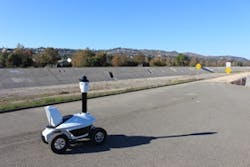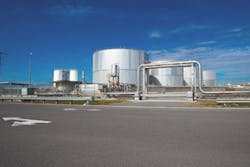Cyber concerns may be all over the news, but ensuring your facilities’ physical security remains an enduring imperative. Industrial and critical infrastructure facilities face an ever-expanding list of threats coming from all directions – land, sea, and air.
Adversarial or innocent trespassers as well as vandalism, sabotage, theft, and malicious attacks are common concerns. Today, there may be weaponized or intelligence-gathering drones flying overhead or submarines underwater. Lone-wolf or organized terrorist attacks are possible. Even an authorized building occupant could “go ballistic.” Are you prepared to handle the possible threats?
Because any security lapse may be presumed to result from negligence, choosing the right set of protective and corrective measures to avoid, detect, and neutralize threats is crucial. Hazards must be anticipated and actively mitigated with measures that are adaptive and resilient and that ensure a rapid response – particularly in dangerous situations.
Having multiple, integrated layers of security and controls will provide optimal protection, and the options available are many and growing. For example:
- Deterrence is aided by fortified perimeters, intelligent access controls, and a visible security presence, whether human or robotic.
- Detection is facilitated by monitoring and sensing systems, radar, sonar, and robots that generate real-time alarms when a security breach or event occurs and when security, process, and safety monitoring systems are integrated and centrally viewable.
- Delaying progression of a threat is possible with more-effective barriers, better locking mechanisms, and isolation of sensitive areas.
- Response is expedited when real-time alarms are received in the control room and on smart devices; mass messages can be communicated; and tools to quickly intercept and neutralize the threat are at hand.
Following are some examples of modern security solutions designed with a common goal: to better safeguard your people, facilities, and company assets and allow threats to be neutralized more quickly and efficiently.
Collaborative security and operations monitoring allows for faster and more coordinated incident response.
Protection at the perimeter
The HyNet Gateway interface provides networking functions to all HySecurity intelligent automated gate operators, barrier arms, and crash wedge barriers. In real time, it detects and logs events such as tailgating by unauthorized vehicles; a gate being forced open; obstructions preventing a gate from closing; a gate staying open for too long; and maintenance issues.
A large, secure employee parking garage serving a major manufacturing plant installed HySecurity gates and HyNet interfaces to monitor vehicle entries and exits at the ACPs and to report critical maintenance and security issues in real time. In Canada, a rail line is currently deploying the gates and interfaces throughout the country to monitor and control shipping traffic at the ACPs.
AI-powered security guard-robots perform unmanned patrols of sensitive areas.
High-strength gates and fences fortify the perimeter of refineries, utilities, government facilities, and other security-sensitive sites. Those that pass the ASTM F2656-07 M50 P1 crash test are able to stop a 15,000-pound truck traveling 50 mph with less than 1-meter penetration of the leading edge of its cargo bed. Examples include the XT-4200 Gate and XL-501 Fence from Ross Technology.
In addition to its strength, ease of installation provides value for the XL-501 Fence design, says Scott Espensen, perimeter security product manager at Ross Technology. Patented energy-absorbing technology reduces material and installation costs. “Our customers have reported back that it takes them roughly half the time to install our post-and-beam fence compared to cable systems, and that translates into significant and tangible cost savings,” Espensen says.
The anti-ram gate is a wide-clearance, rising-beam barrier with an electromechanical drive system. The all-electric system uses a continuous-duty motor, making it “a perfect fit for locations where there are environmental restrictions and the use of hydraulic fluids is prohibited,” says Espensen. In addition, the motor and drive system is located above ground and within the posts to deter corrosion and extend useful life.
Aerial threat control
Drone-mounted thermal imaging cameras are highly effective industrial security and surveillance tools. Unfortunately, sometimes drones are operated for nefarious purposes. Drone detection and tracking solutions such as SpotterRF’s compact surveillance radar help to mitigate this risk.
“With increased threats to security that come from the ever-growing popularity of drones, the A3000 radar and its A-Series counterparts provide the situational awareness that facilities need to protect themselves,” says Andrew Luker, application engineer at SpotterRF.
The textbook-size A-Series counter-drone radar cuts through noise pollution, adverse weather conditions, and lighting to detect the presence of unmanned aerial vehicles – even a small hobby drone that is 1 kilometer away. Interdiction capabilities include blinding the drone’s ability to take videos or photos and jamming its communications.
An electrical substation in Ohio has the counter-drone radar deployed in conjunction with SpotterRF’s C-Series ground radar, allowing it to “detect and track threats from the ground as well as the air,” says Luker.
Another example of counter-drone technology is the AeroGuard Drone Interdiction System from SCI Technology, which captures and disposes of intruding drones in-flight. The company reports that it has an intercept and towing capacity of greater than 55 pounds.
Autonomous security robots
Robotic security guards augment the capabilities of existing security and operations personnel. Large, remote, potentially hazardous, and critical infrastructure sites are prime candidates for the extra “eyes” offered by unmanned patrols. Romeo Power Technology chose the RAD Security Guard Robot (RADbot) from Robotic Assistance Devices to patrol the property surrounding its 113,000-square-foot battery pack manufacturing facility in Vernon, CA.
Access control-point monitoring and protection systems are used to detect and report security and maintenance issues in real time.
The RADbot is a fully autonomous, unmanned ground vehicle that detects and records outdoor activity and alerts security personnel to anomalies. It uses machine vision learning, multiple GPS platforms, inertial navigation, and an obstacle avoidance system to safely and effectively follow its scheduled routes while capturing 360 degrees of video.
Security guard robots serve as a “force multiplier” that can “provide security, deterrence visibility, forensics, and communications where otherwise none would be reasonable to implement,” says Steve Reinharz, president and CEO at Robotic Assistance Devices.
Holistic monitoring capabilities
When security, process, and safety monitoring are integrated with a common operator interface, it improves situational awareness, reduces costs, and enables better, faster, and more coordinated responses.
For example, Honeywell’s Experion Process Knowledge System (PKS) and Experion Industrial Security platforms offer a unified approach. Video surveillance, access control, and perimeter detection are tightly integrated with alarms and events raised in process and safety systems, says Alejandro Giudici, senior consultant for industrial security and fire at Honeywell Process Solutions.
This electromechanical, anti-ram, rising-beam gate provides M50 P1 crash-tested security.
“A customer in Chile uses our solution for security and process monitoring with an integrated CCTV solution to monitor the operation of the site remotely,” says Giudici. “Operators have eyes in the field that help the correct operation of the site from hundreds of kilometers away.” Fire alarms in the same format as all other process system alarms alert the operators the instant a fire starts, he adds.
Honeywell encourages security integration at every stage of a project. For instance, remote security monitoring of multiple construction projects can reduce headcounts and streamline operations, explains Giudici. On completion, the scalable, integrated security solutions “easily transition from the construction phase into full operations, reducing waste and cutting the cost of additional work, equipment, and training,” he says.
EcoStruxure Access Expert (formerly AccessXpert) from Schneider Electric gives security professionals around-the-clock access to video monitoring, intrusion detection and alarms, visitor management, and building management operations. The open, cloud-based system provides remote access so events can be monitored from any location, since security personnel are so often on the move. Use of a cloud service and nonproprietary hardware minimizes implementation costs.
“It is one of the only platforms of its kind with mass-messaging capabilities,” says Steven Turney, security program manager at Schneider Electric. Historically, emergency communication needs were addressed with sirens, speakers, and strobes, he explains. Access Expert’s built-in mass-messaging feature supports both email and SMS texting, allowing security practitioners to quickly and easily communicate with all occupants (employees, contractors, and visitors) at once via their cell phones.
Video display walls from Christie Digital Systems (Christie) are used in the control rooms of many electric utilities, water treatment plants, chemical refineries, and other organizations, allowing for more-efficient security and operations management. Christie manufactures LCD, DLP, and LED display products, including flat panels, video-wall tiled displays, projectors, and indoor direct-view LED displays, in addition to a suite of image processing solutions.
The video walls range in size from 4 feet to more than 255 feet wide and may present a variety of SCADA content, operational dashboards, surveillance camera images, building management system data, digital television channels delivering news and/or weather information, social media activity, and other computer applications in different window combinations depending on the operational state of the facility and the time of day.
“The ability to access, combine, and manage this data together in essentially any format allows customers to create a common operational picture and view information in any number of useful combinations,” says Karl Johnson, director of product management at Christie.
A layered, unified approach to security supported by recent innovations such as those described above may be your best strategy for safeguarding people and property from ever-expanding physical threats.






